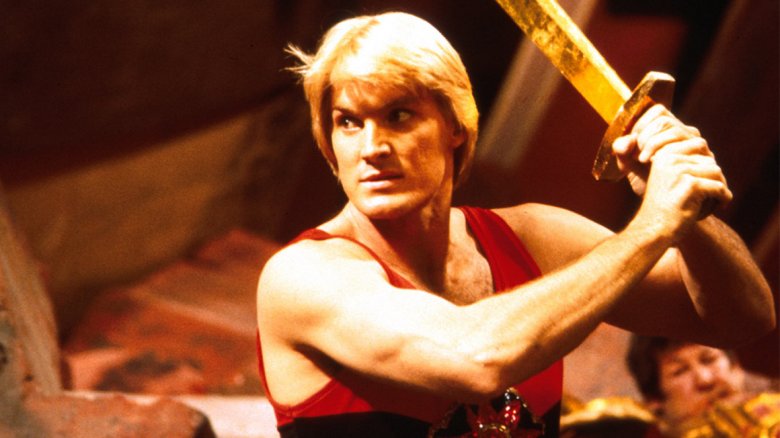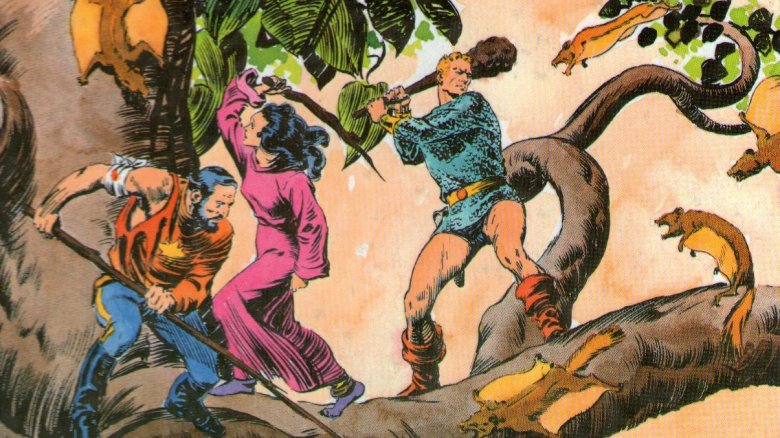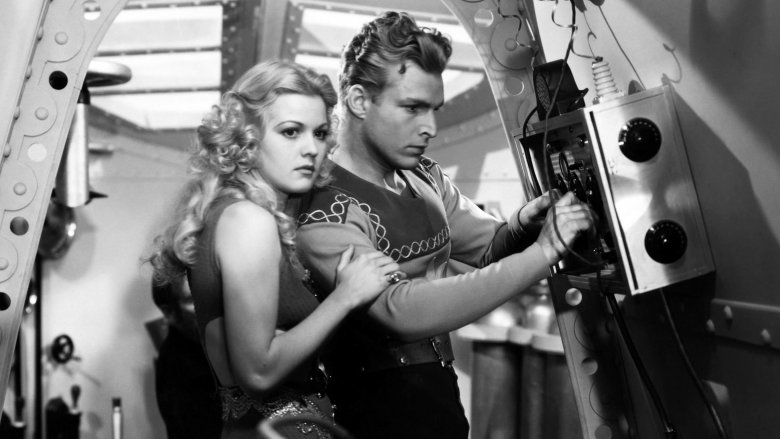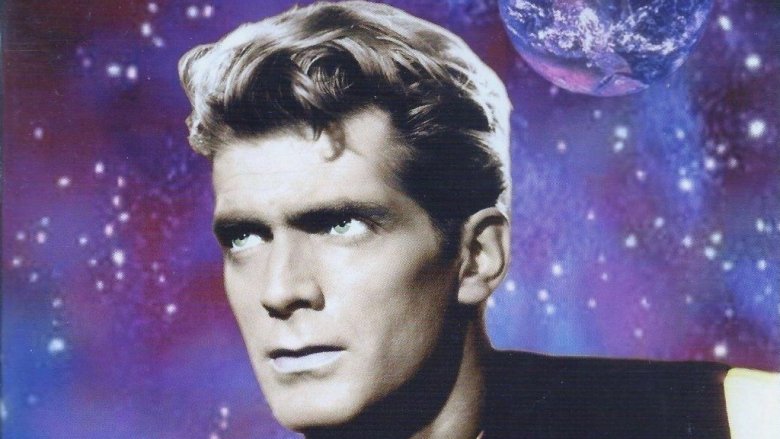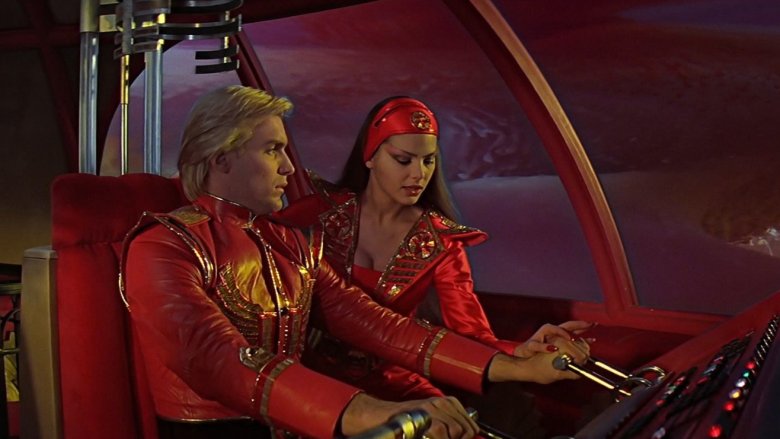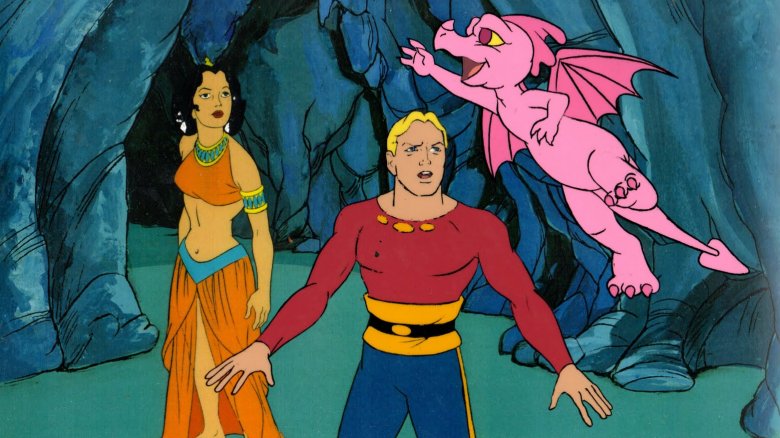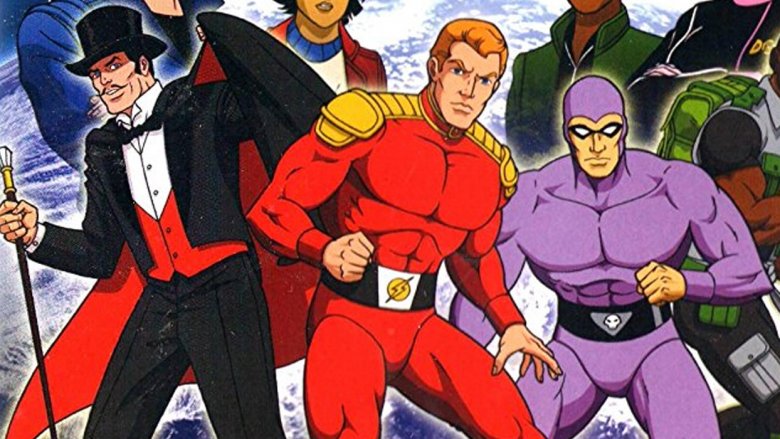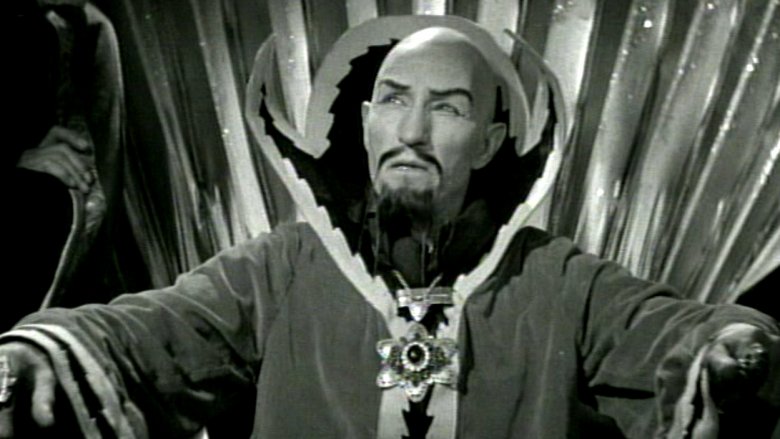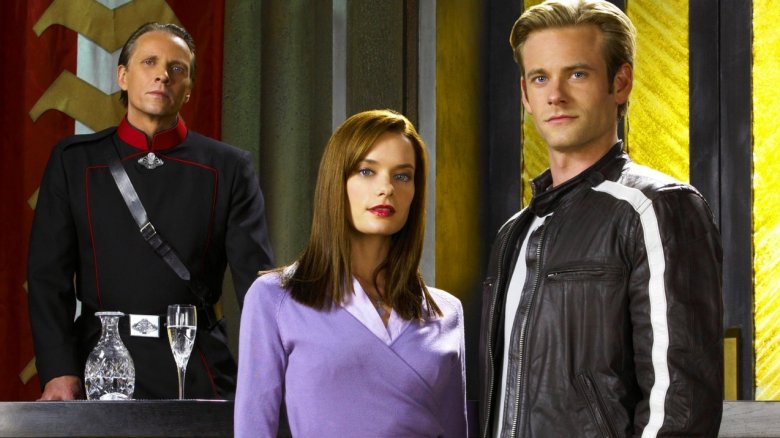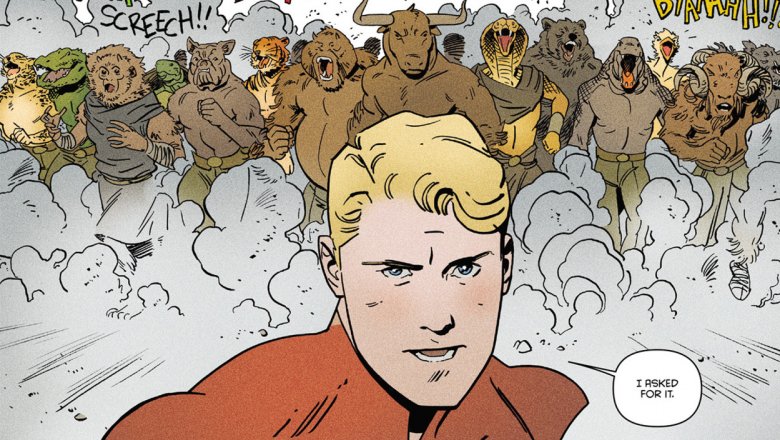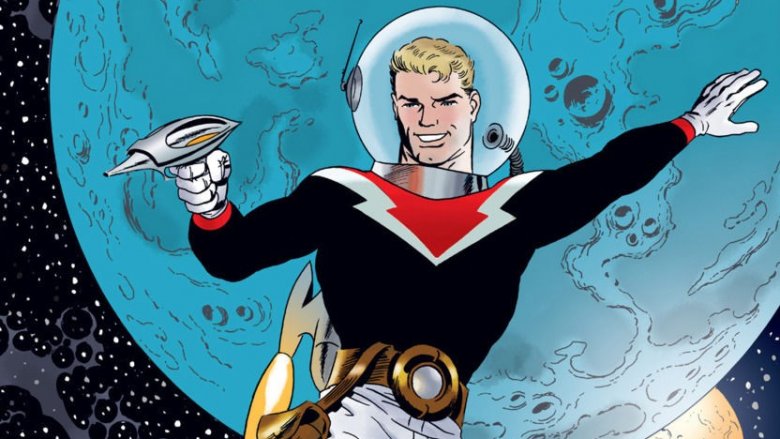Whatever Happened To Flash Gordon?
In this era of a Star Wars movie every year, plus multiple comic adaptations and various other sci-fi adventure blockbusters, there's one name we haven't really seen in a while. Flash Gordon wasn't technically the first great sci-fi hero (John Carter of Mars and Buck Rogers both came before, among others), but he's perhaps the first to spawn a multimedia franchise, appearing in cinemas as early as 1936 and inspiring much of the genre that followed.
So what, you may be asking, is the deal with Flash Gordon? Why does the property seem to have so much staying power, and if it does, why has it been more than a decade since we've seen the property onscreen? The story of Flash Gordon is a long and complex one, winding its way through a variety of media across more than eight decades. Let's dive in and take a look at where Flash got his start — and why his stories have gotten harder to adapt.
Born in newspaper comics
In the early 1930s, King Features Syndicate wanted to publish a sci-fi comic strip that could compete with the wildly popular Buck Rogers. They gave the job to one of their staff artists, Alex Raymond, and he came up with Flash Gordon, which first appeared in newspapers in 1934. Like Buck Rogers, Flash Gordon was an action hero from present-day Earth, but rather than getting cast into the future like his predecessor, Flash travels via experimental rocket to the rogue planet of Mongo, which is threatening the Earth.
On Mongo, Flash and his allies Dale Arden and Dr. Zarkov encounter a variety of strange creatures, including sentient people with the traits of animals, such as the Lion Men and Hawk Men. They foster a rebellion against Mongo's evil dictator, Ming the Merciless. Naturally, Ming has a beautiful daughter, Princess Aura, who turns out to be an okay person, and also flirts with Flash along the way, although Flash's relationship to Dale takes precedence.
Eventually Ming is defeated, with Flash's ally Prince Barin of Arboria marrying Princess Aura and becoming the benevolent ruler of Mongo. Flash and his friends had many more sci-fi adventures after that, but the rebellion against Ming remained the comic strip's defining narrative.
A wildly popular cliffhanger serial
By 1936, Flash Gordon was so popular that Universal Studios adapted the comic into a cliffhanger serial. For those who aren't familiar, serials were like TV shows before there was TV: stories told in 20-minute-ish chapters with suspenseful endings, released to theaters weekly. Serials were mostly aimed at children, but with Flash Gordon, Universal made a push to spend more money, up the quality, and get adults interested as well. Buster Crabbe, an Olympic swimmer who had already played Tarzan, was picked for the lead role, with Charles Middleton as Ming the Merciless, and beauties Jean Rogers and Priscella Lawson as Dale Arden and Princess Aura, respectively.
The serial stuck pretty close to the plot of the early comics. Sets and props from Universal's popular monster films were re-used to make Flash Gordon look great on a limited budget. The serial was so popular that there were two sequels: Flash Gordon's Trip to Mars in 1938 and Flash Gordon Conquers the Universe in 1940. All three serials, but the first one in particular, pioneered the sci-fi adventure genre in cinema and were a major influence on George Lucas's creation of Star Wars.
A divergent TV version
In 1954, Flash Gordon blasted into the newly popular medium of television. The adaptation was particularly loose, with Flash (Steve Holland), Dale (Irene Champlin), and Zarkov (Joseph Nash) now serving as agents of the Galactic Bureau of Investigation in the year 3023. This change in premise allowed them to fly in their spaceship to have a different adventure on a different planet in every episode, rather than focusing on Mongo and Ming the Merciless. Filmed in West Germany, the series proved very popular in the US, with 39 episodes running in syndication during 1954 and 1955.
Although the three leads were American, filming in West Germany meant that practically everyone on each planet they went to spoke with a German accent. Despite the general conservatism of its Cold War mentality, this series was the first portrayal of Dale Arden as a scientist and adventurer in her own right, rather than the perpetual damsel in distress she'd previously been.
Cult movie
In the 1970s, George Lucas wanted to make a new Flash Gordon movie, but the young director failed to get the rights from producer Dino De Laurentiis, who had previously obtained them with the goal of getting Federico Fellini to direct. Lucas decided instead to make something new in a similar space adventure spirit, which of course led to the creation of Star Wars. Ironically, that film's massive success made a Flash Gordon movie inevitable, and De Laurentiis hired Mike Hodges to direct.
With a famous soundtrack by the band Queen, Flash Gordon was released in 1980. In addition to Sam Jones as Flash and Melody Anderson as Dale, it features an extremely impressive cast, including the legendary Max von Sydow as Ming, Brian Blessed as Prince Vultan of the Hawkmen, Timothy Dalton as Prince Barin, and Italian model/actress Ornella Muti as Princess Aura.
The script for the film was written by Lorenzo Semple Jr., who was previously responsible for adapting the 1960s Batman TV series. De Laurentiis wanted Flash Gordon to have a similar campy tone, but Semple and Hodges had a hard time finding the right balance. The finished film has a weird atmosphere and some pretty clunky dialogue and acting, but it's become a cult classic all the same, thanks to its colorful visuals, the Queen music throughout, and the over-the-top performances, especially the unforgettable Blessed as Vultan.
New Adventures in TV Animation
At the same time the movie was in production, Filmation was working hard to bring Flash Gordon back to TV, but this time in animated form. The New Adventures of Flash Gordon premiered on NBC in 1979 and ran until 1982, which means it was on the air when the movie came out, despite not being planned as a deliberate tie-in. The first season is a direct adaptation of the original comics story, with Flash and his friends landing on Mongo and fostering a rebellion against Ming the Merciless. Under pressure for ratings, the studio decided to make the second season more episodic and kid-friendly. That's when a cute pink dragon named Gremlin joined the regular cast, and things went downhill from there. If you're a fan of classic TV animation, you already know that the addition of a "cute" non-human character never bodes well for a series (just ask the Great Gazoo). Inevitably, the series was canceled soon after.
There was another attempt at a Flash Gordon animated series in 1996, in which Flash and Dale were '90s teens on hoverboards, but it only ran for one season and is mostly remembered as a kind of unintentional parody of "extreme" teen-centric '90s adaptations.
Defenders of the Earth
Perhaps the best-remembered animated version of Flash Gordon appears in the 1986 series Defenders of the Earth. Despite being made by Marvel Productions, Defenders featured the stars of three King Features Syndicate comics teaming up, along with their (newly created for the show) teenage kids, to fend off Ming the Merciless. Flash is joined by his son Rick Gordon, the Phantom and his daughter, Mandrake the Magician and his adopted son, and Mandrake's bodyguard Lothar and his son. In a somewhat dark twist, the team's supercomputer hosts the psyche of Dale Arden, Flash's wife and Rick's mother, who was killed by Ming in the premiere episode.
The writing and character development on Defenders of the Earth certainly didn't set the world on fire, but it was fun seeing these old comic strip heroes in an '80s superteam concept. There was also a toyline, so even a Flash Gordon fan who didn't care for the show could land pretty cool-looking action figures of Flash and Ming. However, the Defenders of the Earth version of Ming the Merciless has green skin and pointed ears, which was an attempt to solve an ever-more-glaring problem with the character.
The trouble with Ming the Merciless
Ming the Merciless is an alien, and as such he should have no particular connection to any Earth culture, but of course that's not the way science fiction traditionally works. As his name implies, Ming has elements of Chinese culture, or rather of early 20th Century Western stereotypes of Chinese culture. With his ornate high-collared robes, droopy mustache and long goatee, Ming the Merciless is the very epitome of a "yellow peril" villain. Sax Rohmer's character Fu Manchu is the first and most famous of these racist depictions, and Ming is his direct descendent.
Lacking any real knowledge of Asian cultures, Brits and Americans feared the manipulations of "inscrutable" Asian masterminds, pushing drugs and building criminal empires across the world. Ming was that same idea translated for a sci-fi context: an invading alien dictator posing a threat to the white heroes and their women. Basically, it's a very bad look.
Inevitably, Ming was always played by white actors, which doesn't help. Charles Middleton in the cliffhanger series wore makeup to look more Asian, in the racist Hollywood practice commonly referred to as yellowface. Max von Sydow in the 1980 movie wasn't made up that way, but he still wore the Asian-inspired robes and facial hair. As time passes, Ming increasingly becomes a major problem for the Flash Gordon property. He's widely known as Flash's main arch-enemy, but every trait associated with him seems increasingly problematic.
A failed cable series
The 2007 live-action Flash Gordon TV series on Syfy (then called the Sci-Fi Channel) did its best to solve the Ming problem by eliminating most of what made the character recognizable. He was still played by a white actor (John Ralston, specifically) but was now styled to look like a more European dictator, with slicked-back hair, a clean-shaven face, and a fascistic military-style uniform. On the show, which centered around rifts in space that allow travel between Earth and Mongo, Ming faces off against a young Flash Gordon played by Eric Johnson and Gina Holden as Dale Arden.
The show was widely reviled by critics, and is nearly forgotten a decade after it ended. The plots are uninspired, the production looks cheap, and the lack of rocket ships keeps it from ever really feeling like Flash Gordon. This was when Battlestar Galactica was the Sci-Fi Channel's flagship show, and the difference in quality between that and this is so striking it's hard to believe they were on the same channel at the same time.
Noteworthy comics revival
Flash Gordon has appeared in various comics books over the decades, but things really came together in 2013. That's when the same King Features Syndicate heroes who had once starred in Defenders of the Earth were licensed by Dynamite Entertainment, and appeared together in a crossover comic called Kings Watch. These were new, updated versions of Flash Gordon, Mandrake, Lothar, and the Phantom, but recognizable as the classic characters. The miniseries was written by Jeff Parker with art by Marc Laming, and it was followed by a new Flash Gordon comic by Parker and Evan Shaner.
The Parker/Shaner comic reinvigorated the Flash Gordon story and characters more than anything since at least 1980. Flash himself was a thrillseeker in search of adventure, while Dale Arden is a science reporter who often knows more than he does. Ming the Merciless is the central villain, but he's kept in the background as a barely-seen manipulator, which sidesteps some questions about his representation, at least for a while. The tone of the comic is fun and upbeat without being parodic, which is perfect for Flash Gordon.
Future possibilities
Although the Jeff Parker/Evan Shaner series has come to an end, Flash Gordon continues to appear periodically in Dynamite comics. Beyond that, it's hard to say what the future holds. In 2015, Matthew Vaughn was announced as the possible director of a new Flash Gordon movie. However, there haven't been any updates on that story in years.
A new live-action Flash Gordon is a tantalizing possibility, although the casting and portrayal of Ming the Merciless would definitely be a delicate issue to handle. The tone would also have to be just right: avoiding total camp is one thing, but Flash Gordon needs to be lighthearted and fun, not grim adult sci-fi.
Perhaps the closest character to Flash Gordon in modern pop culture is Peter "Starlord" Quill (Chris Pratt) of the Guardians of the Galaxy movies and Infinity War. Like Flash, he's a daredevil from present-day Earth who finds himself living a life of adventure in outer space. Gamora's even a bit of a Princess Aura stand-in, as the sympathetic daughter of the galaxy's greatest villain, Thanos. As far as a more direct adaptation, however, we'll have to wait and see.
